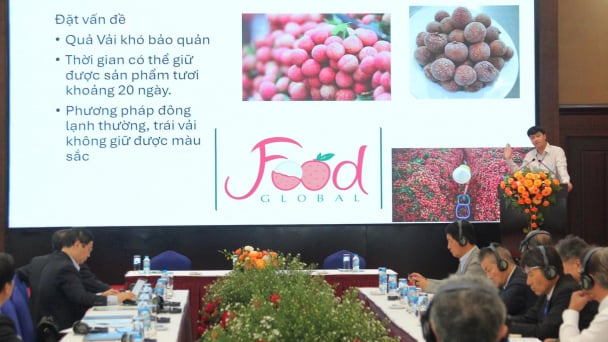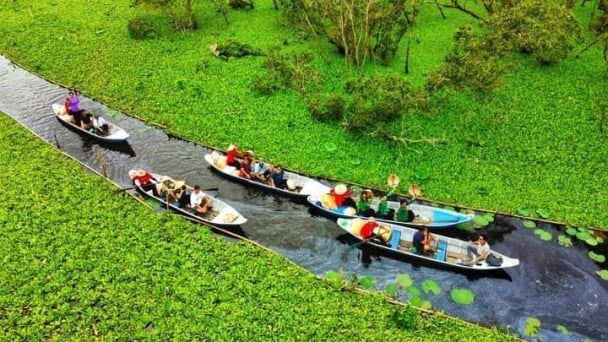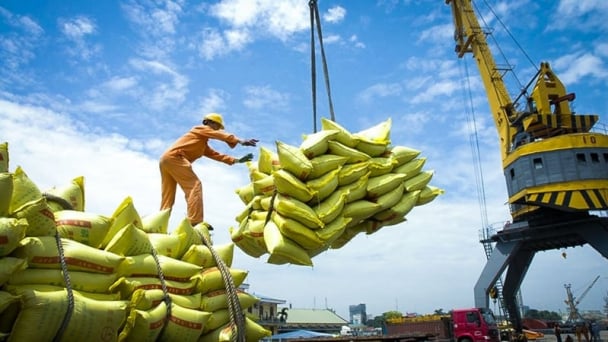June 5, 2025 | 11:00 GMT +7
June 5, 2025 | 11:00 GMT +7
Hotline: 0913.378.918
June 5, 2025 | 11:00 GMT +7
Hotline: 0913.378.918

Deputy Minister Tran Thanh Nam shared in an interview relating to gricultural mechanization. Photo: Bao Thang.
The mechanization of agricultural production has significantly contributed to the reshaping of agriculture and the development of new rural areas. Would you share these outstanding accomplishments?
In the past, agricultural production components have made significant contributions to the production process. In comparison to the previous decade, agricultural mechanization has advanced significantly, as shown by the degree of mechanization achieved of 3.3 hp per cultivated hectare.
The number and variety of agricultural equipment and machinery rose dramatically. From 2011 to 2021, the number of all types of tractors climbed by 60 percent, water pumps by 60 percent, combine harvesters by 80 percent, and fodder processing devices by 90 percent.
Some phases and fields have a high degree of automation, including cultivation from 70 to 100 percent (tilling, irrigation, plant protection), and livestock production from 55 to 90 percent (providing feed and water for livestock). The growth in technology and machinery has somewhat mitigated the effects of the manpower crisis on agricultural output, boosted productivity and product quality, decreased production costs, and assured food safety and cleanliness.
However, our agricultural mechanization has limitations. The average amount of equipment equipped with movers per unit area has risen, but compared to the requirements of industrialization and modernization of agricultural and rural regions, it has not been sufficient. Over 48% of small-scale manufacturing is fostered by asynchronous machinery with a capacity of less than 20 CV. Also unequal is the rate of mechanization across phases.
To raise the production, quality, and value of agricultural goods, it is vital to encourage the synchronous mechanization of the chain's links. Therefore, it is necessary to change the approach to agricultural mechanization and the level of mechanization. In order to satisfy the needs of agricultural and rural industrialization and modernization, the number of dynamic machines per area unit has grown.
In Decision No. 858/QD-TTg of the Prime Minister dated July 20, 2022, approving the Strategy for mechanization of agriculture and processing of agriculture, forestry, and fishery products by 2030, the concept of "synchronous mechanization" was introduced and garnered the attention of numerous scientists, businesses, cooperatives, and individuals. Sir, would you please explain the meaning of synchronous mechanization in agriculture
Previously, we highlighted the use of machines, equipment, and technology as a substitute for human labor, to alleviate labor shortages, or to replace human labor with simple mechanized labor.
However, from a broader perspective, the pace of mechanization in agricultural production in a given area reveals an out-of-sync between stages and phases in the production process, hence impacting production crop, pest and disease control calendars, and climate uncertainties. In addition, the unequal level of automation across stages of the industrial value chain raises production costs.
Following the issuance of Decision No. 858/QD-TTg, MARD is prepared to recommend to the Prime Minister the issuance of a Decree on Synchronous mechanization containing directives to: "Develop agriculture's mechanization in the direction of synchronous mechanization, along the production-to-consumption-to-processing chain. Promote the use of machinery, equipment, advanced technology, digital technology, and smart technologies throughout the agricultural production process."
Consequently, the agriculture industry is able to assure crop output, pest and disease prevention, climate adaptation, and the development of larger-scale models.

The Ministry of Agriculture and Rural Development has advised the Government to issue a strategy for agricultural mechanization.
To accelerate the mechanization of agricultural production, could you outline some core ideas in the near future?
The Ministry of Agriculture and Rural Development has suggested the construction of regional mechanization centers in its suggestions to the government. The regional mechanization center is not a State-established administrative or organization, but rather a center that brings together scientists, businesses, and cooperatives capable of mechanization, new technologies, and smart technology in order to collaborate, link and provide mechanization services and smart technology for agricultural production.
This is also the site to place orders for the research and training work of universities and research institutions, as well as for the standardization of the large-scale automation of raw material regions. The center is comprised of enterprises, cooperatives, institutes, and schools that create their own associations, transmit mechanization and use science and technology to the development of raw material areas.
The function of the state is to guide and encourage growth in order to speed the mechanization process through advantageous land, tax, training assistance, and information-providing laws and methods.
How will MARD work with other divisions and localities to successfully implement particular plans for synchronous mechanization in agriculture?
Transformation of the synchronous mechanization strategy in agricultural output demands close coordination and decisive action on the part of all stakeholders. MARD will examine and advise the government to issue favorable processes and policies to facilitate synchronous mechanization, including the establishment of agricultural machine norms and regulations. In addition, the Ministry will assume primary responsibility for the preparation of a plan for the establishment of a regional mechanization center and supervise its implementation at the local level, in coordination with other organizations.
The Ministry will collaborate on the development of a plan to construct a standardized agricultural, forestry, and fishing materials region. It prioritizes supporting the development of value chain connections, constructing a list of vocations, training curricula, and vocational training for rural employees on the use of agricultural mechanized machinery and equipment, as well as agricultural production services.
In November, MARD plans to host a brief workshop on cultivating agricultural goods and dynamic equipment. This is a chance for farmers to increase awareness about the location and significance of mechanization.
In order to encourage firms, cooperatives, farms, and families to actively participate in agricultural production, the MARD recommended that municipalities develop concrete methods and regulations on mechanization that are appropriate to the local agricultural production scenario.
Businesses, organizations, and individuals must also take the effort to connect raw material regions to consumer regions. It must be acknowledged that agricultural mechanization provides Vietnam with a chance to reorganize the quality of its agricultural products in the direction of efficiency and sustainability. The objective of the entire sector is to get more of our country's products recognized by key international markets, and then to safeguard the brand.
Thank you!
Translated by Linh Linh

(VAN) VAAS and numerous Vietnamese enterprises have signed cooperation agreements with Japanese partners to promote agricultural technology and trade connectivity.
/2025/05/29/5625-12-214801_567.jpg)
(VAN) Provincial mergers in the Mekong Delta promise to streamline administration, expand inter-provincial raw material areas, and foster close linkages in agricultural value chains, benefiting both businesses and cooperatives.

(VAN) Merging Mekong Delta provinces contributes to the expansion of agricultural raw material areas, addressing previous constraints caused by provincial boundaries. Additionally, this expansion will reduce costs and strengthen linkages between businesses, cooperatives, and farmers.
/2025/05/29/1043-2-153730_145.jpg)
(VAN) The Government's policy to merge provincial-level administrative units opens up major opportunities for the Mekong Delta region to reshape its agricultural development strategy toward large-scale production, effective regional linkages, and sustainability.

(VAN) The mutual export of agrifood products between the European Union (EU) and the United Kingdom (UK) must occur again without certification, border controls or other red tape. This was agreed at the UK-EU summit.
/2025/05/22/5121-2-173645_677.jpg)
(VAN) NBSAP Tracker identifies strengths and areas for improvement in the National Biodiversity Strategy, based on each region’s priorities and capacities.

(VAN) The draft amendment to the Circular on rice export trading stipulates a periodic reporting regime for rice exporting enterprises.